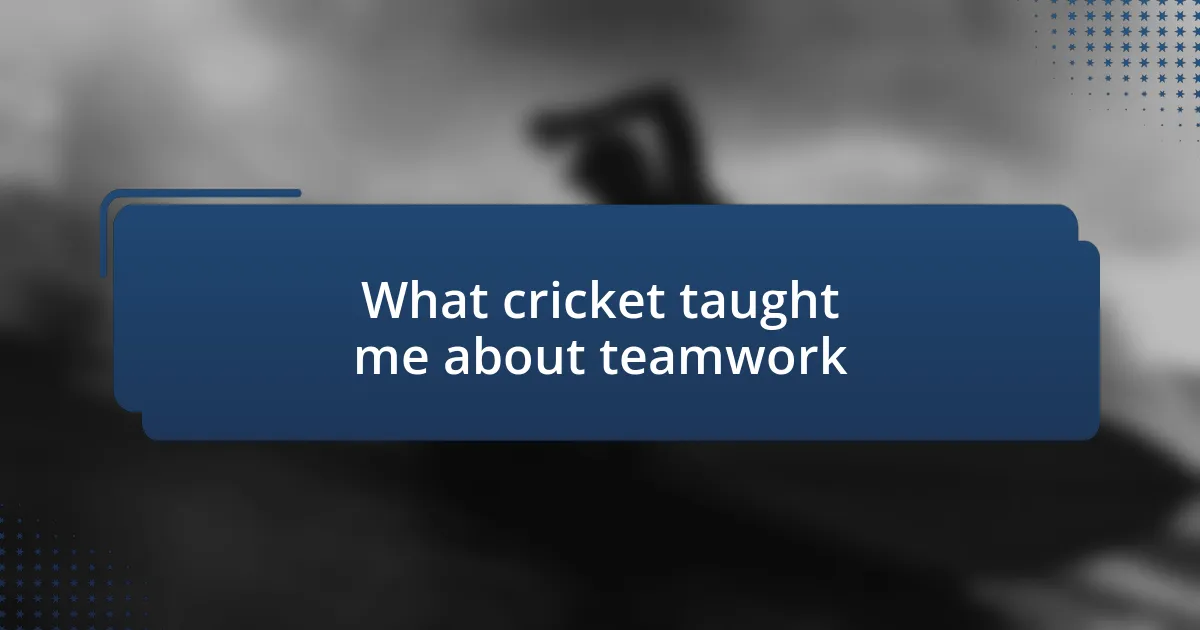Key takeaways:
- Coaching is not only about technical skills but also about nurturing a player’s love for the game and emotional growth.
- Using diverse coaching techniques like demonstration, guided discovery, and constructive feedback enhances player learning and confidence.
- Creating a tailored training plan based on individual assessments fosters skill development and team cohesion.
- Encouraging player insights and reflections on past experiences strengthens game strategies and enhances mental resilience.
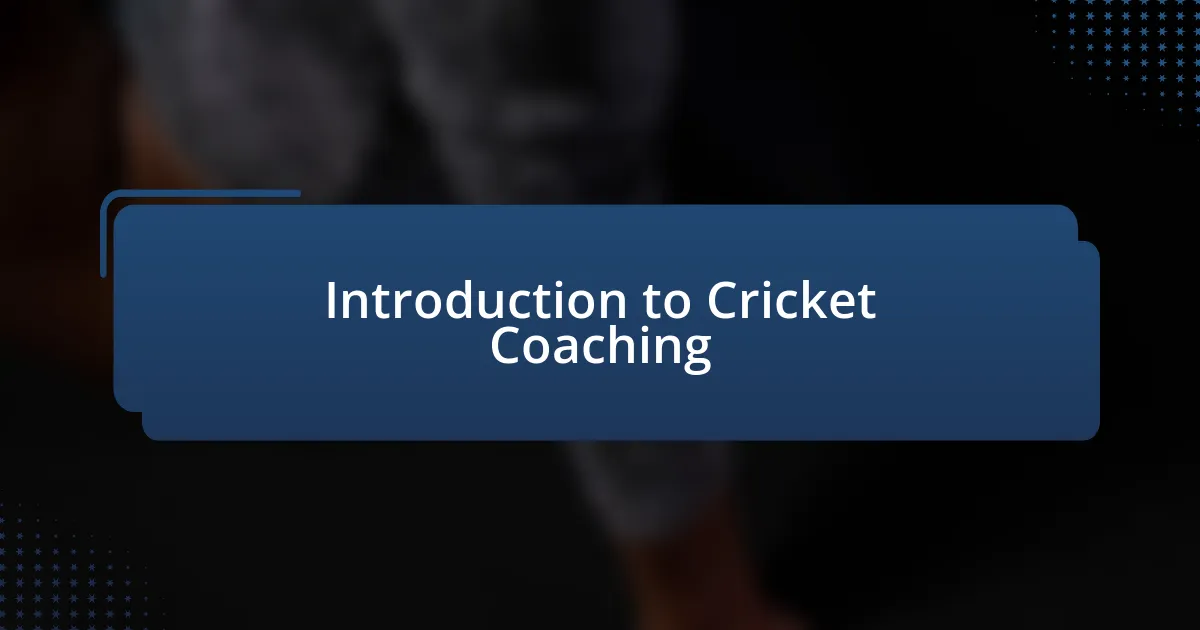
Introduction to Cricket Coaching
Cricket coaching is an art as much as it is a science, blending technical skills with psychological insights. When I first stepped into a coaching role, I was struck by the responsibility of nurturing not just skills but also a love for the game in my players. How do you instill passion in young athletes while teaching them the mechanics of batting, bowling, and fielding?
Reflecting on my early days, I recall a particularly ambitious group of kids, eager to learn but uncertain of their abilities. I remember one young player who had a fierce determination but struggled with his batting stance. After weeks of practicing, the day he hit his first six felt like we both had won a little victory. Moments like these highlight the emotional journey of coaching and how every small achievement can make a big impact.
As I dove deeper into coaching, I realized it’s more than just technical instruction; it’s about building a team spirit. The thrill of watching individuals transform into a cohesive unit is exhilarating. It makes me ask: what truly makes a great coach? Is it the drills, the strategies, or is it the connection forged between coach and player that ignites the spark of potential?
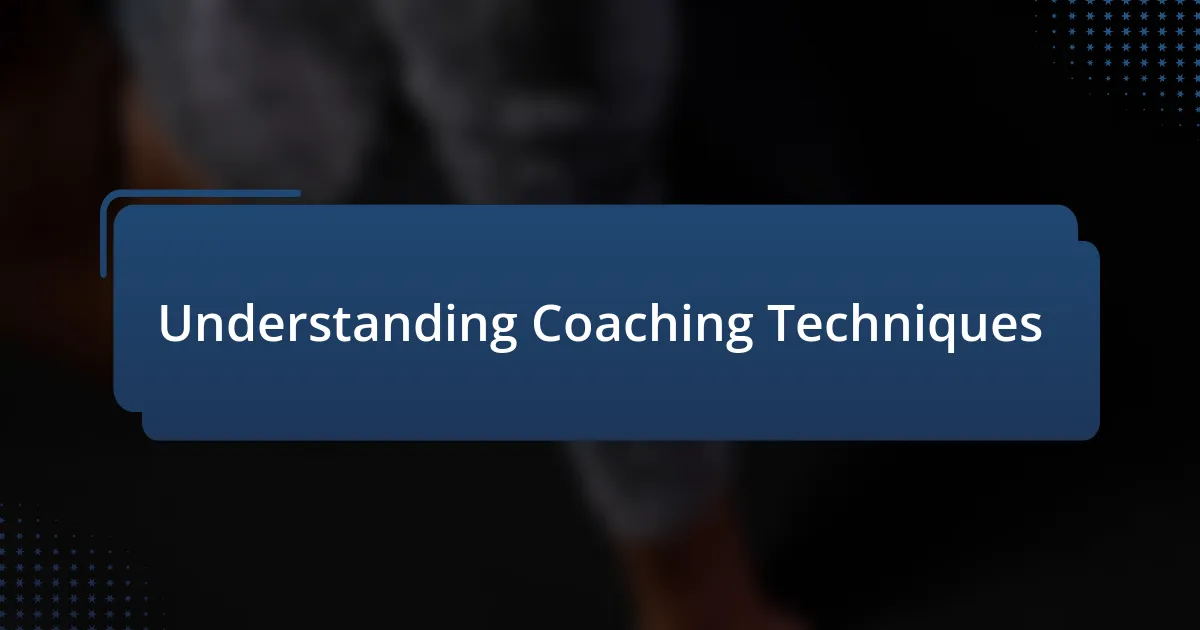
Understanding Coaching Techniques
Understanding different coaching techniques is essential for anyone looking to enhance their skills as a cricket coach. I’ve discovered that techniques like demonstration, guided discovery, and feedback can significantly impact players’ learning experiences. For instance, using demonstrations to showcase a proper bowling action has helped many young athletes visualize what is expected, allowing them to mimic and refine their movements.
One particular coaching session stands out in my memory. I had a group that struggled with teamwork; they often played individually, ignoring each other’s strengths. By implementing guided discovery techniques, I encouraged them to explore their roles within the team. The transformation was remarkable. They started supporting each other, leading to improved performance and stronger bonds—not just on the field, but off it too.
In my experience, feedback is crucial. It can make or break a player’s confidence. I recall a moment when I provided constructive feedback to a young bowler after a match. Rather than focusing solely on negative aspects, I highlighted what he did well, followed by areas for improvement. The smile on his face after our discussion showed me how powerful encouragement can be, fostering resilience and a willingness to learn.
| Coaching Technique | Description |
|---|---|
| Demonstration | Showing players the correct technique through visual examples. |
| Guided Discovery | Encouraging players to find solutions through exploration and questioning. |
| Feedback | Providing constructive criticism to promote growth and improve performance. |

Building a Training Plan
When building a training plan, I emphasize the importance of tailoring it to the needs of the players. In my experience, incorporating individual assessments helps identify strengths and weaknesses. It’s about understanding where each player sits on their cricketing journey. For instance, while working with a young all-rounder, I noticed he thrived on fielding drills but struggled with batting under pressure. By focusing on these gaps, I was able to create a plan that addressed his specific challenges, fostering both confidence and skill development.
Here’s how to structure a successful training plan:
- Assessment: Evaluate each player’s skills through drills and match situations.
- Goal Setting: Establish clear, achievable objectives based on assessments.
- Skill Development: Design drills that target specific areas for improvement.
- Progress Tracking: Regularly review and adjust the plan as players develop.
- Variety: Introduce different drills and exercises to maintain engagement and interest.
- Team Integration: Ensure training fosters teamwork, reflecting the importance of playing as a unit.
Incorporating these elements has transformed my coaching sessions. I once had a player who was adamant about his batting technique. By embedding his feedback into the plan and allowing him to take ownership, he became more receptive and willing to adapt, ultimately leading to his best performance yet. It’s moments like these that remind me of the profound impact a well-structured training plan can have on both skills and camaraderie in a team.

Developing Player Skills
Developing a player’s skills goes beyond simple drills; it’s about creating an environment where they feel safe to learn and make mistakes. I recall a young fast bowler I coached who was terrified of bowling in matches. I chose to incorporate competitive yet supportive scenarios during practice, allowing him to build his confidence gradually. Watching him finally take those strides onto the pitch was rewarding.
As players progress, the balance between technique and mental resilience becomes critical. I often ask myself, “How can I make my players more adaptable under pressure?” One approach I’ve implemented involves simulating high-stakes scenarios during practice. The excitement I see in their eyes as they learn to manage the pressure reminds me why I love coaching. Each breakthrough, whether executing a perfect delivery or maintaining composure, reinforces the importance of psychological preparedness in developing holistic cricket skills.
Lastly, I find it invaluable to celebrate small victories, which cultivates a positive atmosphere. I remember working with a young batsman who was frustrated with his strike rate. After a month of focusing on pacing and shot selection, he scored a match-winning fifty. When he looked up, beaming with pride, I felt his joy resonate with me. It’s these moments of growth that truly illustrate the journey of developing player skills, where every little achievement fuels their love for the game.
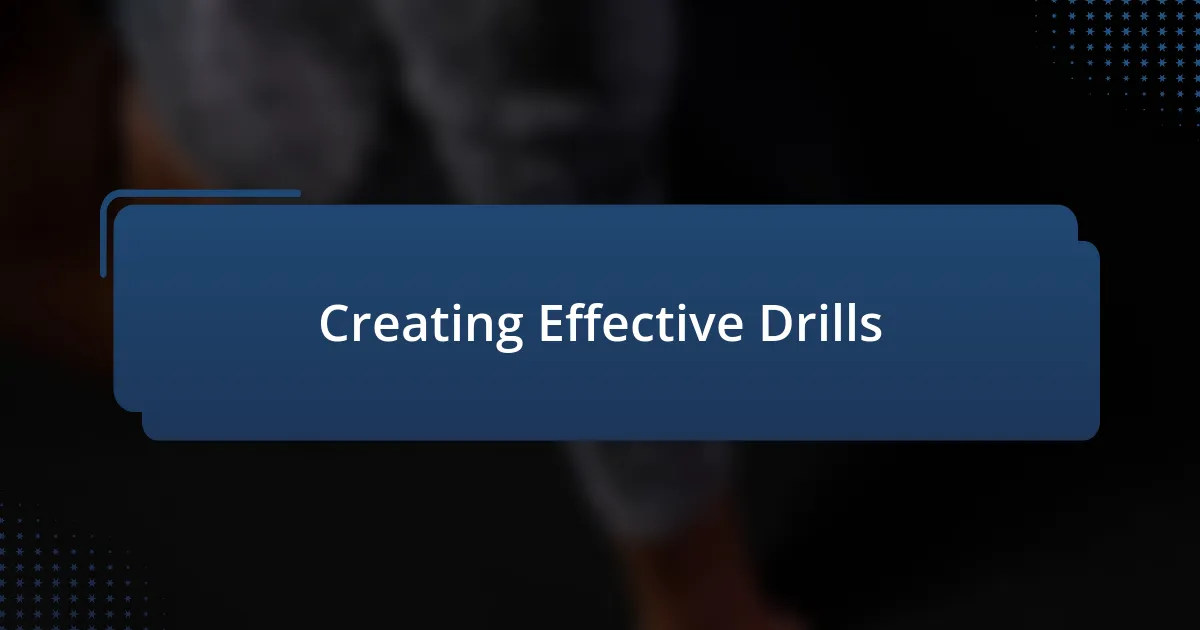
Creating Effective Drills
Creating effective drills is crucial to a player’s development. I remember designing a fielding drill that incorporated sudden changes in direction. It was simple yet effective, and I watched as my players not only improved their agility but also learned to anticipate the game better. Isn’t it amazing how a well-planned drill can transform a player’s mindset and performance?
I’ve found that tailoring drills to each player’s needs can make a significant difference. One season, I had a struggling wicketkeeper who lacked confidence in his reflexes. I introduced a target-based catching drill where we used tennis balls to improve his hand-eye coordination. The thrill in his eyes when he started catching consistently was priceless. Have you ever seen someone realize their potential? Those moments are what make coaching worthwhile.
Drills should also emphasize teamwork, as cricket is inherently a team sport. During one practice session, we set up a communication drill where fielders had to call out plays while responding to each other’s movements. The synergy that unfolded was remarkable. It reminded me how essential communication is on the pitch, and the smiles shared among teammates highlighted a moment of connection that goes beyond skillful play. How often do we overlook these fundamental aspects in training?
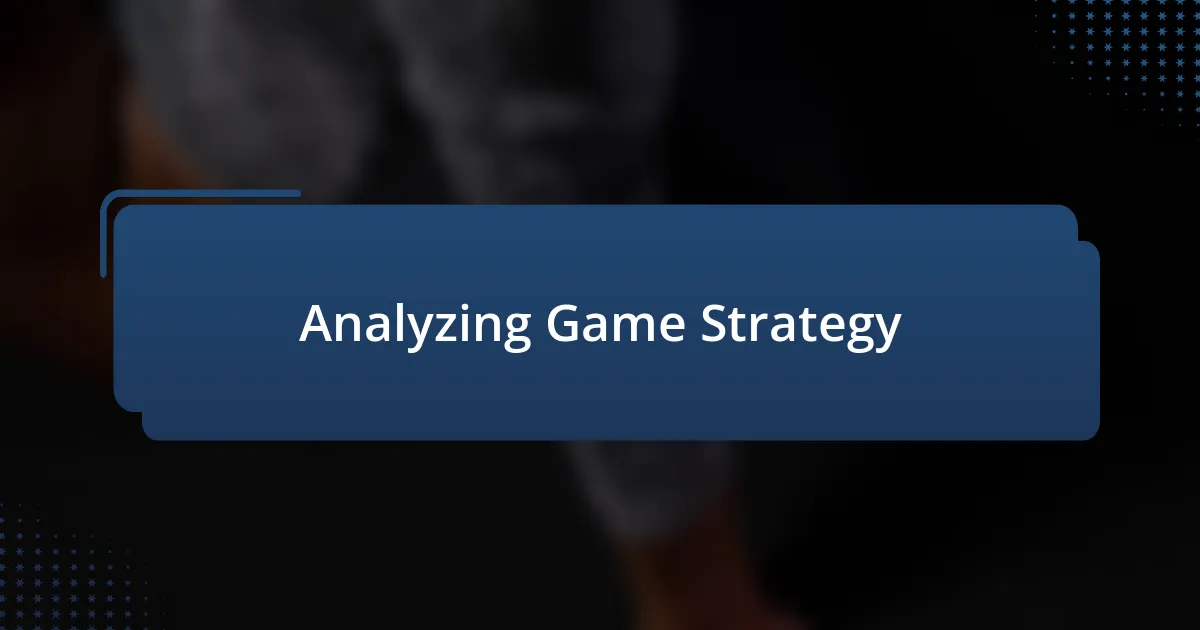
Analyzing Game Strategy
Analyzing game strategy goes beyond just decisions made during play; it’s about how players understand their roles within a larger framework. I recall a pivotal match where, as a coach, I focused on dissecting the opposition’s strengths and weaknesses before the game. We created a strategy around their key player, opting to bowl at different angles to throw him off his rhythm. Seeing my team adapt mid-game, applying our analysis in real time, was a testament to our preparation. How often do we realize that strategy is as much about adjusting on the fly as it is about prior planning?
I also found that encouraging players to express their insights often leads to unexpected perspectives. After a challenging match, we held a debriefing session, and one young player surprised me by noticing patterns in our opponents’ batting. I could see the light bulb moment when he connected those patterns to our upcoming games. It was a reminder of the power of dialogue in strategy formation; sometimes the best strategies come from the players themselves. Have you ever felt that spark of inspiration when brainstorming with your teammates?
Moreover, I believe analyzing game strategy requires a balance between offense and defense. During one season, our focus shifted from merely attacking to implementing a solid defensive strategy. By dissecting previous matches, we pinpointed areas where careless fielding had cost us runs. I remember the pride I felt as our team’s confidence grew with each successful defensive play. Isn’t it rewarding to witness a team transform their mindset to value both sides of the game?

Reflecting on Coaching Experiences
Reflecting on coaching experiences reveals the essence of growth in both players and myself. One moment stands out when I realized the impact of consistent feedback. After a particularly tough training session, I gathered the players and shared my personal struggles with mastering certain skills. I noticed how my vulnerability not only opened up a space for them to share their challenges but also bonded us as a team. Isn’t it fascinating how vulnerability can create an environment conducive to growth?
In another instance, I found that the memories of past matches often resurfaced during training. Whenever we faced a similar scenario, I would remind the team of a game where a last-minute play changed everything. It was then that I understood the power of storytelling in coaching. Players connected emotionally with those stories, motivating them to push harder in similar situations. Have you ever experienced a moment in sport that inspired you to dig deeper than you thought possible?
An essential aspect of my coaching journey has been witnessing the evolution of players’ mindsets. There was a season where our team struggled with self-belief, so I introduced mental resilience exercises. Gradually, I noticed a shift; players began to approach challenges with renewed confidence. Their triumphant reactions after achieving small victories fueled a sense of empowerment within the team. Don’t you think that this internal growth often surpasses physical achievements in its importance?



